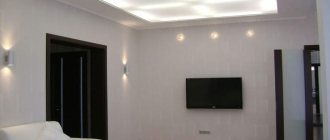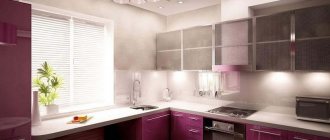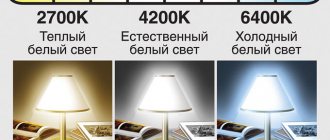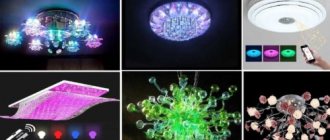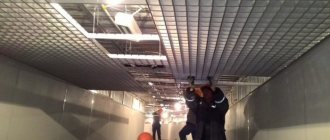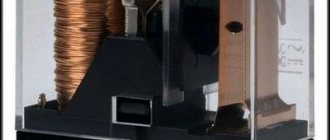The Armstrong suspension system is a practical, inexpensive and stylish option for finishing the ceiling, actively used in public and commercial buildings. A wide range of textures and colors allows you to give the top floor an original look, and the functional design provides excellent opportunities for individual lighting design. Finding the right lamp for Armstrong is extremely easy! Various types of lighting fixtures can be integrated into this ceiling system. You just need to choose the right lamps and understand the features of their installation.
Armstrong ceilings and their features
This type of ceiling system has a characteristic and recognizable appearance - a flat surface divided into squares. The basis of the structure is a metal frame. It consists of various profiles that are connected to each other with special latches and attached to the ceiling using hangers.
The main feature of the Armstrong ceiling is its square cells of standard size 600x600 mm. They are filled with lightweight mineral fiber-based slabs. The panels lie on a metal profile, supported only by their own weight. This allows you to quickly dismantle them - for example, to install a lamp or to gain access to communications.
Types by installation method
Lamps can be built into Armstrong-type ceilings or placed externally. This will not affect the quality of lighting, but may slightly change the appearance of the ceiling.
Ceiling lamp designed for fluorescent lamps
Built-in, completely recessed into the structure. All the filling is hidden in the space between the armstrong and the ceiling. Its main advantage is ergonomics; the ceiling looks monolithic.
As for the external type, it protrudes slightly beyond the ceiling line. An important advantage of this type is its high light output. You can successfully mount both one and the second type; the choice depends solely on your own preferences.
LEDs inside the lighting fixture
It is worth noting that not all lighting fixture designs currently on the market have standard sizes. So the American ones, which were the first on the market, are 60.5x60.5 cm. The European standard is 59.5x59.5 cm. You also need to pay attention to this point when choosing a lantern according to the installation method.
Types of LED ceiling lights Armstrong
To organize lighting in rooms with hanging systems of this type, various lighting devices are used. The classic solution is Armstrong ceiling lamps, which are designed specifically for installation in suspended ceilings. They have a square shape and standard dimensions (600x600 mm). There are elongated or shortened models. Also, for installation on Armstrong ceilings, spotlights are actively used - single and double, fixed and rotating.
Based on the method of integration into the suspension system, lighting devices are divided into two categories:
- Built-in. The lamps are mounted inside the cell. Their body is recessed inside to a depth of 20 cm, and only the diffuser remains visible from above. This type of lamps allows you to create smooth ceilings without protruding elements.
- Invoices. They are mounted on top of the plates installed in the cell or in their place with a small protrusion. Surface-mounted luminaires diffuse light better and exhibit higher brightness. The only drawback is the body protruding above the ceiling line.
Driver (power supply)
To be able to connect overhead and recessed Armstrong lamps to a standard 220V household outlet, a driver is used that adapts the nature of the incoming current to devices running on LEDs, and also passes it in only one direction. The driver ensures the quality of the supplied light and extends the life of the lighting equipment.
Driver Specifications:
- Efficiency (standard indicators 80 - 90%).
- Power factor (cos φ or λ, or Pf) shows the relationship between the total power and the one that is supplied (active, corresponding to the energy consumption of the device). If Pf is incorrect (up to 0.5), traffic jams on the meter will be knocked out due to network overload. The correct option Pf is more than 0.9. This parameter (when purchasing LED equipment) is calculated by summing the power factor of drivers of the same type simultaneously connected to the network, and also if there is a current limit in the power network.
- Peak inrush current. Appears during the initial charging of the driver capacitors, can exceed the nominal parameters tens of times, and lead to damage to high-sensitivity network equipment. Conventional circuit breakers usually do not have time to react to a sharp increase in the starting current. This value is not indicated in the passport, so it is recommended to discuss the possibility of returning the device if it turns out that it cannot work due to the level of inrush current. The problem can be recognized by an excessively loud click of the spark when the LED lamp is turned on.
- Ripple coefficient - determines the stability of the current supplied by the driver and the luminous flux. The latter’s pulsation frequency of 50–100 Hz is not perceived by the human eye, but has a negative effect on the body; readings of 300 Hz or more do not cause a negative reaction in the brain. To check the pulsation level of a particular Armstrong lamp, you need to point your smartphone camera at the light stream - if stripes start to “run” on the screen, then the pulsation exceeds the permissible level and it is not recommended to buy such a device. Our company sells equipment that meets all SNiP and SanPiN standards.
- Resource (reliability and durability of the driver). The indicator depends on the quality of the components (in particular, capacitors) that make up the device. A high-quality device will work without problems for tens of thousands of hours, while low-quality equipment will only work properly at first, but within a year it will fail due to a cheap capacitor with a short lifespan. Therefore, when choosing a driver, you need to consider the warranty period (must be more than 3 years).
To accurately measure all the characteristics of Grilyato and Armstrong ceiling lamps, a goniophotometer is used. This is a bulky measuring complex that is expensive, and only specialized laboratories and large manufacturers can afford it. Therefore, when purchasing lighting fixtures, you still need to trust our professionals, who are aware of the characteristics of the product presented on the website. We sell equipment that meets all SNiP and SanPiN standards. Consultants will help you choose a device for installation in industrial, medical, educational, residential, etc. premises.
Advantages of lamps for Armstrong
Modern lighting technology, created for integration into suspended ceiling systems of this type, has a huge number of advantages.
The main advantages of Armstrong lamps are:
- quick installation by replacing one ceiling slab with a lamp;
- universal design that goes well with any interior;
- light weight of the device and easy to maintain design;
- absolute silent operation and no overheating;
- bright and even light output with uniform dispersion;
- affordable price compared to other models;
- wide selection of front panels (different shades and textures).
Many lighting design experts believe that Armstrong lamps are the best choice for lighting large spaces. In addition, the light they emit is the most comfortable for long-term work.
Main characteristics
Armstrong LED lamps are popular among entrepreneurs due to their technical characteristics. Economy comes first. In a plant that uses hundreds of these bulbs, the financial benefit becomes significant.
It is proposed to consider the technical characteristics using the example of a 32 V SPVO LED ceiling lamp.
Lighting parameters:
- luminous flux – 2700 lm (lumens);
- lamp efficiency – 84 lm/W;
- radiation angle – 120 degrees;
- color temperature – 3000 K (kelvins).
Electrical characteristics:
- power consumption 32 W (watt);
- supply voltage 170-264 V (volts);
- supply frequency 50, 60 Hz;
- current consumption no more than 0.2 A (ampere);
- Efficiency 95%;
- class of protection against electric shock – 1.
General characteristics:
- operating temperature range from -20 to +45 degrees;
- protective panel material – prismatic plexiglass;
- degree of protection from external influences – 40 IP;
- case material – aluminum;
- warranty period – 3 years;
- dimensions without packaging 595x595x79 mm;
- net weight 3.9 kg.
Design of a lamp for a suspended ceiling Armstrong
Almost the entire line of lighting devices for ceiling systems of this type has a similar design. The lamps have a metal body made of light aluminum alloy. Depending on the dimensions of the model, its weight can vary from 0.5 to 3-4 kg. Inside the case there are light sources (LED strips, fluorescent lamps), batteries (wires, starting equipment, transformer unit), reflectors and other components.
The main element of any lamp is the diffuser. The simplest option is open mirror grilles. However, they are only appropriate in public areas. For commercial and other facilities, lamps with plexiglass or plastic diffusers are used. Such panels hide the internal structure of the device, contribute to the correct distribution of the light flux and soften its intensity.
Diffusers come in three main types:
- “Opal” is a homogeneous matte sheet with a light transmittance of 80%;
- “Prism” - with a fine-grained texture and light transmission of 90%;
- “Cracked ice” - with a relief texture that transmits about 85% of light.
The degree of protection of the housing from the external environment varies. For rooms with a normal microclimate, models with IP20-IP40 are offered. For objects with aggressive environments, Armstrong lamps with protection IP54 and higher are used.
Lighting devices of this type can additionally be equipped with a battery. It plays the role of an emergency power supply unit (EPU), providing light sources with energy in the event of a power outage through the central network.
How to read fluorescent lamp labels?
The diameter of the lamp tube on the marking is indicated by the letter T with a digital code corresponding to the diameter expressed in eighths of an inch. The T8 marking, corresponding to a lamp diameter of 26 mm, is widely used. Accordingly, T5 will indicate a diameter of 16 mm, and the code T4 means that the diameter of the lamp is only 12 mm. The letter G with a digital code indicates the correspondence of the lamp to a specific base. For example, G13.
Another important code is the three-digit one. It shows the type of phosphor. Lamps with a code of 840 are perfect for lighting office spaces, while a light source with a code of 530 is suitable only for a garage, utility room or kitchen, since it produces light in warm tones with poor color rendering and light output. Objects around you will appear low-contrast and brownish.
Application
Armstrong lamps can be found wherever suspended ceiling systems of the same name are installed. The main area is shopping centers, shops and boutiques. Also, this line of lighting devices is actively used at the following facilities:
- office and administrative premises;
- hotel complexes;
- restaurants, fast foods and cafes;
- sports centers and gyms;
- warehouse and technical premises;
- industrial workshops and workshops;
- medical and educational institutions.
Armstrong ceiling lamps are usually installed in rows along the windows, which allows you to create an imitation of daylight in the evening. Another popular solution is to install lighting fixtures in a checkerboard pattern. This option allows you to achieve the most uniform dispersion of light over the entire area.
Safety precautions
The Armstrong ceiling lamp is an electric lighting device, so when connecting it you should follow safety precautions:
- Before working with electrical wiring, the cables are de-energized.
- Before touching the cables and after installation, use an indicator to check that there is no current.
- It is necessary to carefully insulate the cables used for connection.
- When working, use tools with plastic or rubber handles.
- Do not carry out the connection alone; in case of electric shock, a second person will be able to provide first aid.
- Take care of grounding.
- It is better not to make a connection through twisting. This method is very unreliable.
- Connect power to the panel only after checking all insulation and correct connection.
- If you do not have any skills in working with electricians, it is better to entrust the connection to specialists; the prices for such work are quite affordable.
Comparison of LED and fluorescent lamps under Armstrong
Lighting devices for suspended ceilings on the market operate primarily on two types of lamps. The first option is T8 fluorescent, and the second is the increasingly popular LEDs. Both types have advantages and disadvantages. To make it easier to choose a lamp for an Armstrong suspended ceiling, we suggest comparing these models:
- Resource. Fluorescent devices operate for approximately 8,000 hours. LED lamps significantly surpass them in this indicator - about 50,000 hours. These are figures guaranteed by the manufacturer, often confirmed in practice.
- Durability. Flickering and a decrease in brightness by more than 60% are inevitable consequences of active use of a fluorescent lamp. LEDs, even after 5-8 years of operation, retain up to 75% of their original brightness.
- Energy efficiency. LED lamps are the most economical. They do not require long heating and consume little energy. Compared to fluorescent analogues, such lamps consume 2.5-3 times less energy.
- Resistant to voltage surges. Fluorescent lamps are very demanding on the quality and stability of the current. Their LED analogues can easily withstand voltage surges of up to 1000 Volts, after which they continue to work in standard mode.
- Light output. The maximum luminous flux power of fluorescent lamps is 70 Lm. And the higher the indicator, the more energy is consumed. LED lamps surpass them in light output - more than 120 Lm per Watt.
- Pulsation of light. An important parameter for objects where constant visual control over equipment and devices is important. The ripple of fluorescent devices reaches 15%, and of LED devices - no more than 4%.
- Lighting comfort. Fluorescent lamps produce a harsh, cold stream of light that can quickly tire the eyes. LED lamps offer a wider range of glow: from warm soft to neutral daylight.
- Environmental friendliness. LED lamps are safe for humans and the environment. They do not contain toxic vapors or other toxic substances that pose a threat if the flask breaks.
As you can see, LED lamps for Armstrong pendant systems are the preferred choice in many respects. Such lighting fixtures will allow you to organize room lighting to high standards, making the design of the ceiling spectacular and practical.
LEDs for lighting
Armstrong LED lamps are highly valued by customers thanks to:
- Durability along with low cost factor;
- High luminous efficiency and energy-saving performance.
Their use in a wide variety of designs makes it possible to present it in the most favorable light, because LEDs are capable of emitting all possible colors in the visible spectrum, being an excellent alternative to lighting using fluorescent lamps.
They save electricity consumption well, and there is no need to replace lamps. If you organize lighting correctly, you will notice how the efficiency of work output will increase with a noticeable reduction in costs.
What is a diffuser?
The diffuser in an Armstrong ceiling light is a plate that is placed on the bottom of the light fixture. It is made of transparent material, from which different effects emanate. The following diffusers are available today:
- Opal.
- Prism type.
- "Cracked Ice"
Each has its own characteristics and original appearance. This closed ceiling lamp looks more solid. The disadvantage of using it is the loss of about 100 lumens from the original brightness.
Spotlight
